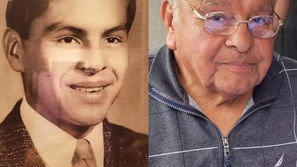Lile presents State of District address
- Tyler Takeda
- Nov 3, 2021
- 4 min read

Wendy Alexander/The Madera Tribune
Todd Lile speaks during the State of the District address on Oct. 19 at Matilda Torres High School.
After one of the toughest years anyone could imagine, Madera Unified School District Superintendent Todd Lile is confident his district has addressed many problems and is looking towards a positive future.
At the beginning of 2020, Lile and his staff had to figure out how to educate the many students within the district through a worldwide pandemic. Then, the issues of Black Lives Matter and the changing of how students are taught had to be addressed.
Through it all, Lile and the district remains positive moving forward as stated in the State of the District address on Oct. 19 at Matilda Torres High school.
“Since Friday, the 13th of March in 2020, our students and staff have been trapped in a maze of guidance documents, policies, mandates, technologies, tears and anxieties,” Lile said in the address.
Lile said to use that setback as a moment rise to the occasion.
“Everyone realizes that over the years, we have struggled to consistently reach our own expectations,” Lile said. “This is even more true today as we assess the severity of our students’ learning loss. We must take this moment to rise up.”
Lile explained that in the fall of 2017, the district began a relationship with the National Center on Education and Economy to engage their executive development program based on best practices studied in high performing school systems around the world.
“This intense work has opened our minds to new possibilities,” he said.
Lile also explained that the view of students has to change.
“The traditional view of our students as full of deficits still hides in plain sight in our culture,” he said. “Like a bad habit, it still causes us to imagine we’re doing well enough. This view has become comfortable and convenient. When we don’t recognize and confront it, we sometimes fool ourselves into believing we have good relationships with our teachers and students. Their comfort equates to our convenient existence.”
In the spring of 2020, nearly 80 site and district leaders engaged in deep learning. The District Systems Design Partnership remained a school system built in this decade to meet modern student and community needs.
“Every teacher and school in the world was forced to adapt, but Madera’s staff had new intellectual tools and most ouf leaders could see new future outcomes,” Lile said. “We challenged ourselves to set higher standards for ourselves, even in a crisis.”
Lile also addressed the needs of the students’ mental health.
“Our behavioral health clinicians, psychologists, and health staff have been positioned to support our students as never before just when we needed them most,” Lile said.
He also pointed to the partnerships with Camarena Health Centers and the Madera County Public Health Department for taking care of the school community. MUSD was one of the first districts to offer staff vaccinations and testing, tracing and community clinics have held up as a state model.
“Last year taught us the value of focusing on the needs of others,” he said. “We have listened, learned, and adapted a great deal by collaborating with adults.”
Lile also said that this time in the pandemic showed how valuable the connection between a student and a teacher is and is emphasizing that going forward.
“Classroom level connections are essential,” he said. “Stories remind us that student behaviors originate not from a hardwired brain, but from an emotional being that needs to be seen and understood. Hearing these personal tales remind us students want to see how to successfully fit into our school and their own future lives.”
Lile pointed out that last year, the average age of onset depression is 14.5 years old. He hopes that by having students interacting with teachers, it will help.
“We have more students engaged than at any time in district history,” he said. “We can resist the pressures causing the depression and anxiety with intentionality and leadership.”
Moving forward, Lile hopes that the new classroom will help all children, no matter what race.
“We are actively working on adding materials, resources, and experiences into our education that reflect their family heritage,” he said.
However, the while expectations of of the classroom have risen, Lile says that the expectations of the teachers have also risen.
“Higher expectations in our classrooms start with higher expectations of our instructional leaders and greater importance on the value of our teacher leaders,” he said. “While COVID may have derailed our best efforts in the first few weeks, we are now leveling into a new and more manageable norm. It is up to us to be in classrooms, visiting professional learning communities, sponsoring project-based learning, finding authentic phenomena and dilemmas to study and aligning our graduate profile. It is up to us to collaborate with our teacher leaders to keep our Strategic Action Plans alive and to respond to the resources they need. We must make a commitment to a stronger sense of trust and shared accountability for quality lessons, strong first instruction, adequate in-class support, and multiple opportunities to learn and demonstrate mastery.
“One size has never fit all students and it has never fit all educators either. Inspired students come from inspired and energized adults. The conditions are improving. The phoenix is rising.”
Although the district has had to deal with many obstacles over the past year, Lile said the future looks bright and sees a positive tomorrow.
“In the Student Champions of yesterday, I see a reason to believe in tomorrow,” he said. “And I see the light of the phoenix rising.”


























Comments